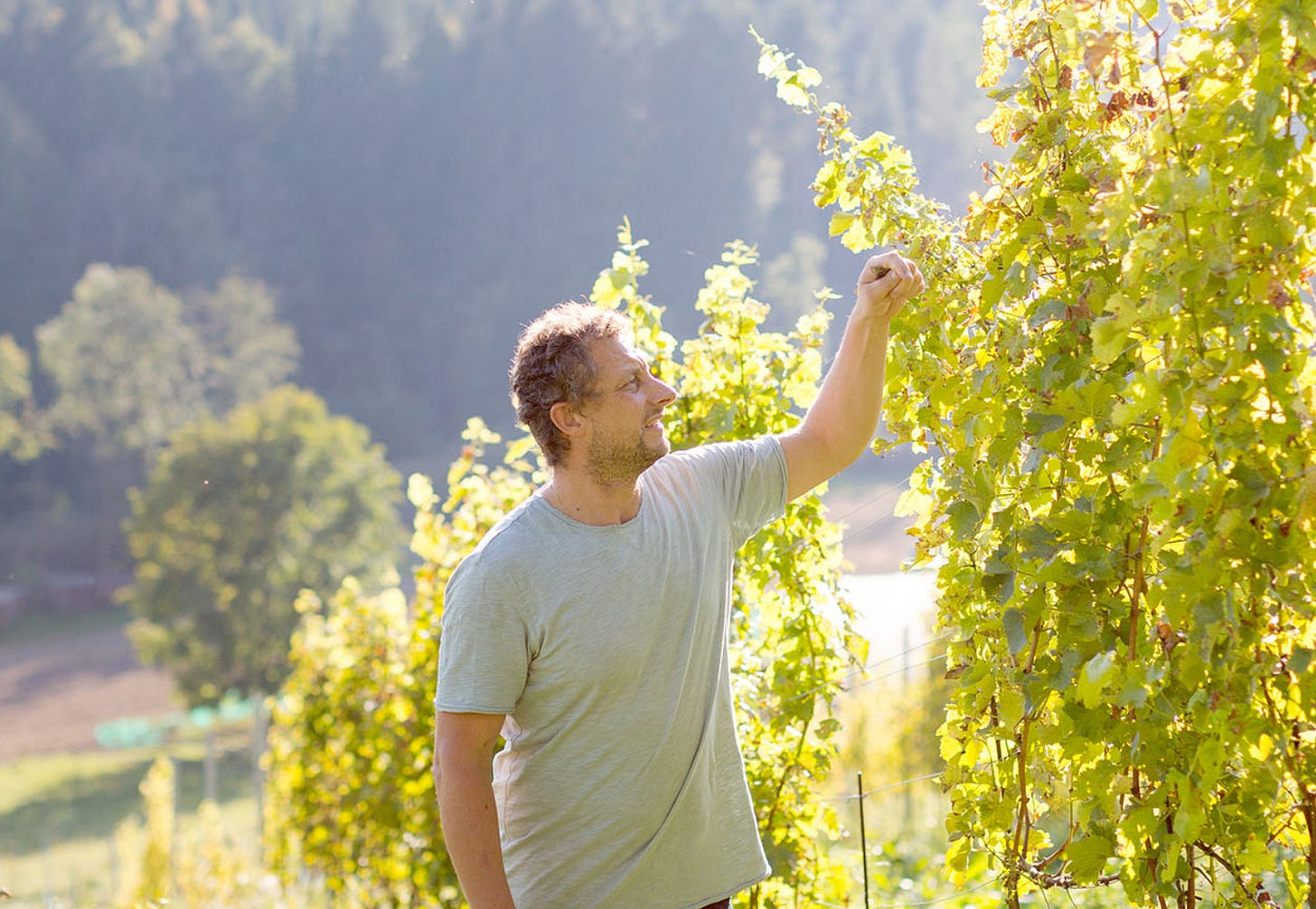In Carinthia, Viticulture is Start-Up Culture
"Anyone who wants to make wine has to start from scratch"
Thank you to Archetyp for sponsoring this post! You can learn more about their Carinthian wines and wine club here.
If you were to hear about a group of scrappy business owners defying convention and skeptics in pursuit of a singular goal, you might think you were in for another round of tech entrepreneur self-mythologizing. Yet this particular story takes us far from Silicon Valley, and instead to the land of Austria’s tallest peaks. Welcome to Carinthia, Austria’s most up-and-coming wine region, and one of the few areas in the Austrian Alps where wine is being made today.
“A lot of people tell us we’re the crazy ones,” says Sabine David, who co-founded the Vulgo Ritter estate with her husband in the town of St. Paul im Lavanttal. David was an industrial engineer in the city of Graz who initially thought she would try making wine as a hobby. After planting some vines on her grandmother’s property in Carinthia, she and her husband were compelled to purchase a local farm to build out their winemaking operation. “The stable for the cows, I turned into the cellar. The neighbors thought, ‘she’s crazy.’ ”

Part of the incredulity is due to the fact that there is so little wine being produced in Carinthia right now–only 130 hectares of plots exist today. Moreover, there was no wine being made in the region at all for many years; while evidence of religious-linked viticulture in Carinthia dates back to the year 822, local winemaking fell off for reasons ranging from the Little Ice Age to the late 19th century Phylloxera outbreak to the shift towards beer under Bavarian rule. Only in 1972 did wine in Carinthia mount a comeback, when a certain Herbert Gartner planted a small vineyard in Burgstall bei St. Andra. To this day there are no wineries available to take over, so anyone who wants to make wine has to start from scratch.
But David is not alone, and has a small group of similarly passionate peers who embrace the challenges of making wine in Carinthia. Like her, they tend to be outsiders of non-winemaking backgrounds, such as former hockey player and electrical engineer Alexander Egger, and restauranteurs Sem Kegley and Georg Lexer. In the absence of a more established winemaking culture, the producers of Carinthia look to each other for support, bound by a spirit of collaboration and co-creation.

And also, the belief that they’re onto something special. Carinthia is part of the Bergland, or the “mountain land,” an impressive swath of territory in Western Austria that also includes the states of Tirol, Salzburg, Upper Austria and Vorarlburg. The Bergland is the opposite in every way from Austria’s Burgenland in the East, where exceptional Blaufränkisch is made but at lower-altitude in a warmer climate. In fact, almost all of Austria’s wine production is currently based in the East, near the borders with Czech Republic, Slovakia and Hungary. But Carinthia, located on the borders with Italy and Slovenia and home to Austria’s highest mountain (the Grossglockner), has a climate that winemakers like David believe is completely unique, both within Austria itself and among other Alpine wine regions.
“Some people always compare us with Alto Adige in Italy, but they’re open to the south, so they get warm, dry air from the south,” says David. “In the south of Carinthia, we have the Alps, so we have the high mountains, also in the east, the west, and in the north. We are in between. So we really have the Alpine climate. We have high humidity, so we have a lot of rain.”
The advantage, as David sees it, is that the grapes can have a long growing season, acquiring more pronounced flavors without becoming high in alcohol. While Sauvignon Blanc is harvested now in August in neighboring Italy, Ritter’s grapes can hang on the vines until just before the first snowfall. “We can leave the grapes in the vineyards, and not increase the sugar anymore. We know the aromas are developing. And that’s really a benefit that we have to our climate within the Alps.”
Another draw to the terroir is its relatively untouched quality; because Carinthia is in the mountains, the land was never used for large-scale agriculture, so the soils have good nutrition. They are diverse, ranging from chalk to limestone, and can be very old in areas that weren’t covered in glaciers in an earlier era. The abundance of surrounding forests also contribute to biodiversity which keeps potential insect problems in check, although David says the local birds love going in for the grapes.
As a new wine region, Carinthia does not have as much of a tradition of growing native grapes, although producer Gerhard Köck is known for his wines with the Austrian hybrid grape Roesler. Instead, most of the wines are made of internationally-known varietals, with 80% of production going to the whites (Sauvignon Blanc, Chardonnay, Muscat and Riesling) and 20% to the reds (Pinot Noir, Zweigelt, Merlot, Cabernet Sauvignon and St. Laurent). There are plenty of opportunities for producers to experiment with different grape varieties on different soils, but the common qualities to the wines, like so many Alpine wines, are high acidity and relatively low alcohol, with the latter often hovering around 12%.
It’s in the cellar where the upstart nature of the winemakers comes through, choosing not to interfere much with the wines, in part because they simply lack the training to do so. The results are pure wines that reflect the quality of the vineyard and the character of the vintage, taking on a slightly different form each year. Ironically, these very traits–low intervention, terroir-specificity and vintage variation–are in fashion now even among the wine orthodoxy. “Sometimes it’s good if you know not everything,” David muses.
Yet despite all of the progress and potential of Carinthia, marketing the mountain wines within Austria has proven to be an uphill battle. Austria is an affluent nation with active wine promotional bodies, but, according to David, Carinthia has yet to see any government investment; “You have to come up with the business on your own.” She finds that foreigners are often more interested in her region’s wines than her own countrymen, and, present tariff uncertainties notwithstanding, she’s had better success selling her bottles to the States. Vulgo Ritter wines are distributed in the U.S. by Archetyp, the Alpine-focused direct-to-consumer retailer that’s currently the only company representing Carinthian wine in the States.
But even without outside investment, the wines of Carinthia have been gaining recognition, and with good reason. Ritter’s award-winning Sauvignon Blanc is aromatic and polished, made in a style that’s sure to please international palates. Meanwhile, Weingut Sternberg’s skin contact “Amphore” field blend seems poised to be a hit at natural wine bars. The featherweight Pinot Noir from Kegley & Lexer is unmistakably Alpine, in many ways more akin to the Nebbiolos of Valtellina than to the Pinot Noirs of better-known wine regions.


“Overall Carinthia is currently one of the most dynamic ‘new’ wine regions in the Bergland and due to the climate change I think we can expect some really fantastic wines from there,” affirms Katja Scharnagl, the Austrian-born sommelier and former beverage director of New York City’s Koloman.
David also believes that climate change will make the Carinthian venture impossible to ignore, given the cooler climate, abundant rainfall, and the sustainable viticulture practices that were integrated at the outset. “I think a lot of people will see in the next five to ten years that there is a big benefit to growing wine in the Alps.” But for now, she’s still relishing the freedom that comes with being part of an undervalued region. “I can do what I like to do with my wine, I have no boundaries…They buy the wine, or they don’t buy it.”
In Case You Missed Them —
A Summer Book List
I’ll be the first to admit it, I live for seasonal rituals. The start of each season brings with it certain events, activities, and habits that I not only look forward to but that help me feel refreshed and rejuvenated after the excitement of the current season gradually gives way to monotony. Food and drinks are, of course, a big part of that excitemen…
The Alpine Gem on New York's North Fork
It's strange to have the feeling of a homecoming in a place you've never been before, but that was my experience while visiting Alpina restaurant in Greenport, NY on an early summer weekend. It was not long after we created the Alpine Wine Society that the presence of a Swiss-Italian Alpine restaurant on the tip of the North Fork of Long Island became k…
The 3 Most Important Things We've Learned about Alpine Wine (so far!)
This month, the Alpine Wine Society turns three! Three years ago, amidst the retreat of the global pandemic and the manic resumption of in-person activities, Julia and I asked ourselves if anyone would want to read a newsletter dedicated to wines from a niche, largely undiscovered wine region. It turns out –










